Prurigo nodularis
Prurigo nodularis is a skin disease characterised by intense itching and inflammatory, nodular skin changes.

Prof. Marie-Charlotte Brüggen MD, Head Physician of the Department of Dermatology at the University Hospital Zurich, explains the causes, symptoms and treatment options of the disease.

Prof. Marie-Charlotte Brüggen MD
Head physician, Department of Dermatology, University Hospital Zurich
Prurigo nodularis - the most important facts at a glance
Here you will find comprehensive information on the skin disease prurigo nodularis.
Prurigo nodularis and atopic eczema (also known as neurodermatitis) are both skin diseases that manifest with itching and inflammatory skin changes. Individuals with atopic eczema can develop prurigo nodularis, as the chronic itching and frequent scratching can lead to nodular skin changes. Both diseases are inflammatory in nature and are influenced by similar immunological mechanisms.
The main characteristics of this chronic skin disease are severe itching and numerous nodular skin changes that can affect large areas of skin all over the body - especially those accessible to scratching. In addition to itching, other skin symptoms such as pain, burning and stinging often occur. Prurigo nodularis is considered to be the skin disease with the most intense form of itching. Sufferers find the itching to be the most distressing part of the disease.
Prurigo nodularis is most common in adults between the ages of 40 and 70. It affects women more frequently than men. The frequency of the disease varies greatly in different countries and is estimated at 100 cases per 100,000 people in our latitudes.
The cause of prurigo nodularis is not yet fully understood. However, it is known that the nodular skin changes are just the visible part of the disease. Research assumes that there is a disruption in the interaction between the nervous and immune systems which ultimately leads to severe itching. Various immune cells are involved. The skin changes are caused by constant scratching triggered by persistent itching.
Atopic eczema sufferers are at increased risk of developing prurigo nodularis: Chronic itching and frequent scratching can lead to the nodular skin changes. Both diseases are inflammatory in nature and can be caused by similar immune system defence mechanisms. Early and effective treatment of atopic eczema can help reduce the risk of developing prurigo nodularis.
The diagnosis of prurigo nodularis is initially based on a clinical skin assessment. It is important to record the patient's medical history in detail in order to identify possible triggers and concomitant diseases such as atopic eczema or allergies. Skin tests or blood tests can help rule out other skin diseases and check for inflammation. Itching and its impact on the quality of life of sufferers are also assessed. In some cases, a tissue sample (biopsy) may be necessary to confirm the diagnosis and rule out other skin diseases.
Various treatment options are available to prurigo nodularis sufferers. These include topical (applied to the skin), primarily anti-inflammatory therapies such as corticosteroids and calcineurin inhibitors. Systemic drugs in tablet form , for example, antihistamines, immunomodulators or neuromodulatorss, can help. More recent approaches include drugs in injection form, known as biologics. These biologics are antibodies that block inflammatory and itch-promoting messenger substances or their receptors. This allows them to reduce itching.
The chances of recovery are variable and depend on the individual's response to treatment; while some patients experience significant improvement, the disease can remain chronic and long-lasting in others.
In addition to drug therapy, UV light therapy can help alleviate the symptoms, as it has an anti-inflammatory effect and can reduce itching.
There are also psychosocial therapy approaches that help sufferers cope better with chronic itching and stress factors. Through therapy, coping strategies can be learned and the quality of life significantly improved.
The aim of research is to develop other treatment approaches optimally tailored to sufferers’ needs, i.e. their specific inflammation profiles. Such individualised therapies could have a more precise effect on the underlying inflammatory processes and thus enable more effective treatment.
Prurigo nodularis sufferers face various challenges. These include chronic itching, leading to severe skin damage due to frequent scratching. This can not only affect the skin, but also significantly worsen the quality of life. Many sufferers experience sleep disorders, anxiety and depression.
- For skin care, regularly apply a moisturising product. This helps strengthen the skin barrier and can help relieve itching. When taken straight from the fridge, it also has a cooling effect and soothes itching.
- Various measures can provide relief for acute itching, e.g. cooling compresses, pressing a cool spoon or cool bag wrapped in cloth against the itchy area, holding the itchy area under cold running water, then applying cream as usual.
- As sweating promotes itching, do not cover up too warmly at night and wear clothing adapted to the temperature during the day.
- Relaxation techniques (e.g. yoga, progressive muscle relaxation, autogenic training) can help deal with severe itching and stress.
- Regular medical check-ups with a dermatologist help adjust the therapy where necessary and recognise possible complications at an early stage. Psychological support may be useful in the event of severe mental stress.
Editors: aha! Swiss Allergy Centre in co-operation with the Scientific Advisory Board.
Final revision of the website content: 26.11.2024





